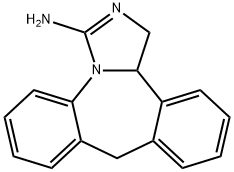CHEMICAL AND PHYSICAL PROPERTIES
| Physical Description | Solid |
|---|---|
| Melting Point | 205-208 °C |
| Solubility | 1.63e-01 g/L |
| LogP | 3.51 |
SAFETY INFORMATION
| Signal word | Danger |
|---|---|
| Pictogram(s) |
 Exclamation Mark Irritant GHS07  Health Hazard GHS08  Environment GHS09 |
| GHS Hazard Statements |
H302:Acute toxicity,oral H372:Specific target organ toxicity, repeated exposure H411:Hazardous to the aquatic environment, long-term hazard |
| Precautionary Statement Codes |
P273:Avoid release to the environment. P280:Wear protective gloves/protective clothing/eye protection/face protection. |
COMPUTED DESCRIPTORS
| Molecular Weight | 249.31 g/mol |
|---|---|
| XLogP3 | 3.5 |
| Hydrogen Bond Donor Count | 1 |
| Hydrogen Bond Acceptor Count | 1 |
| Rotatable Bond Count | 0 |
| Exact Mass | 249.126597491 g/mol |
| Monoisotopic Mass | 249.126597491 g/mol |
| Topological Polar Surface Area | 41.6 Ų |
| Heavy Atom Count | 19 |
| Formal Charge | 0 |
| Complexity | 378 |
| Isotope Atom Count | 0 |
| Defined Atom Stereocenter Count | 0 |
| Undefined Atom Stereocenter Count | 1 |
| Defined Bond Stereocenter Count | 0 |
| Undefined Bond Stereocenter Count | 0 |
| Covalently-Bonded Unit Count | 1 |
| Compound Is Canonicalized | Yes |
PRODUCT INTRODUCTION
description
Epinastine is a benzazepine that is 6,11-dihydro-5H-dibenzo[b,e]azepine in which the azepine ring is fused to the e side of 4,5-dihydro-1H-imidazol-2-amine. It has a role as an anti-allergic agent, a histamine antagonist, an ophthalmology drug and a H1-receptor antagonist. It is a member of guanidines and a benzazepine.

